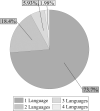Am I truly monolingual? Exploring foreign language experiences in monolinguals
- PMID: 35312725
- PMCID: PMC8936441
- DOI: 10.1371/journal.pone.0265563
Am I truly monolingual? Exploring foreign language experiences in monolinguals
Abstract
Monolingualism has typically been understood as a homogeneous phenomenon. The linguistic experiences of monolinguals are usually overlooked when analysing the impact of foreign language experiences on language processing and cognitive functioning. In this study, we analyse the linguistic experiences of 962 English-speaking individuals from the United Kingdom (UK) who identified as monolinguals. Through an online survey, we found that more than 80% of these monolinguals had learned at least one foreign language, dialect, or type of jargon. More than half of this 80% of monolinguals also used languages they had learned at some point in their lives. Moreover, nearly 40% of all the studied monolinguals confirmed that they had been passively exposed to foreign languages or dialects in their environment; approximately a fourth of these monolinguals who declared exposure to at least one foreign language (or dialect) confirmed that they also used these languages. Furthermore, activities that involved passive use of languages (i.e., activities that require reading or listening but do not require speaking or writing; e.g., watching TV) were occasionally carried out in foreign languages: around 26% of these monolinguals confirmed the passive use of more than one language. Lastly, around 58% of monolinguals who had visited one or more non-English-speaking countries declared the active use of foreign languages during their stay(s). These results suggest that the linguistic experiences of monolinguals from the UK often include exposure to and use of foreign languages. Moreover, these results show the need to consider the specificity of the monolingual language experience when analysing the impact of foreign languages on cognitive functioning, as differences in the language experiences of bilinguals also have divergent impacts on cognition. Lastly, monolingual experiences are different from bilingual experiences; therefore, existing questionnaires that evaluate language experiences should be adapted to capture the particular linguistic experiences of monolinguals.
Conflict of interest statement
The authors have declared that no competing interests exist.
Figures




Similar articles
-
Predictors of verbal fluency performance in monolingual and bilingual children: The interactive role of English receptive vocabulary and fluid intelligence.J Commun Disord. 2021 Jan-Feb;89:106074. doi: 10.1016/j.jcomdis.2020.106074. Epub 2021 Jan 4. J Commun Disord. 2021. PMID: 33450631
-
Home Language Will Not Take Care of Itself: Vocabulary Knowledge in Trilingual Children in the United Kingdom.Front Psychol. 2017 Aug 10;8:1358. doi: 10.3389/fpsyg.2017.01358. eCollection 2017. Front Psychol. 2017. PMID: 28848473 Free PMC article.
-
Foreign language effect in decision-making: How foreign is it?Cognition. 2020 Jun;199:104245. doi: 10.1016/j.cognition.2020.104245. Epub 2020 Mar 26. Cognition. 2020. PMID: 32222524
-
Language processing in bilingual aphasia: a new insight into the problem.Wiley Interdiscip Rev Cogn Sci. 2016 May-Jun;7(3):180-96. doi: 10.1002/wcs.1384. Epub 2016 Mar 16. Wiley Interdiscip Rev Cogn Sci. 2016. PMID: 26990465 Review.
-
[Linguistic portrait of a Russian-German speaking woman with dementia : Longitudinal observations from a German language nursing home].Z Gerontol Geriatr. 2022 Jul;55(4):276-280. doi: 10.1007/s00391-022-02065-z. Epub 2022 Apr 8. Z Gerontol Geriatr. 2022. PMID: 35394190 Review. German.
Cited by
-
The Nuance of Bilingualism as a Reserve Contributor: Conveying Research to the Broader Neuroscience Community.Front Psychol. 2022 Jun 24;13:909266. doi: 10.3389/fpsyg.2022.909266. eCollection 2022. Front Psychol. 2022. PMID: 35814120 Free PMC article.
-
Bilingualism is always cognitively advantageous, but this doesn't mean what you think it means.Front Psychol. 2022 Aug 16;13:867166. doi: 10.3389/fpsyg.2022.867166. eCollection 2022. Front Psychol. 2022. PMID: 36051209 Free PMC article.
-
Moving away from deficiency models: Gradiency in bilingual speech categorization.Front Psychol. 2022 Nov 24;13:1033825. doi: 10.3389/fpsyg.2022.1033825. eCollection 2022. Front Psychol. 2022. PMID: 36507048 Free PMC article.
-
The Multifaceted Nature of Bilingualism and Attention.Front Psychol. 2022 Jun 3;13:910382. doi: 10.3389/fpsyg.2022.910382. eCollection 2022. Front Psychol. 2022. PMID: 35719564 Free PMC article. Review.
References
-
- Bloomfield L. Language. New York (NY): Holt, Rinehart and Winston; 1933.
-
- Grosjean F. Bilingualism: A short introduction. In: Grosjean F, Li P, editors. The psycholinguistics of bilingualism. Hoboken (NJ): John Wiley & Sons; 2013. p. 5–25.
-
- Mackey M. The description of bilingualism. In: Wei L, editor. The Bilingualism Reader. London: Routledge; 2000. p. 26–54.
-
- Surrain S, Luk G. Describing bilinguals: A systematic review of labels and descriptions used in the literature between 2005–2015. Biling Lang Cogn. 2019;22(2):401–15.
Publication types
MeSH terms
LinkOut - more resources
Full Text Sources

